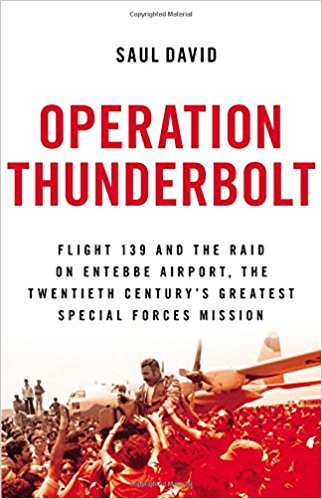Title: Operation Thunderbolt: Flight 139 and the Raid on Entebbe Airport, the Most Audacious Hostage Rescue Mission in History
Author: Saul David
ISBN: 9781444762549
Page Count: 446 pp.
Publisher: Little, Brown & Company
This isn’t a new story, but an old story done differently.
I can’t remember the first time I watched “Raid on Entebbe”, one of the first films about Operation Thunderbolt. But it stuck. This brave, ballsy mission to move 4000km to rescue hostages is one of the greatest true stories in modern military operations. Yet it’s been told so many times it’s lost its luster, but in this book, it finds it anew.
In Operation Thunderbolt, Saul David shows that the mission was nothing but precise, at least not within those eight days. An accomplished military historian, David weaves a compelling narrative around the golden thread we all know. The result is a fast-paced account reconstructed from interviews, diaries, official documents, previous accounts and some of the best research I’ve witnessed in a history book. It’s an edge-of-the-seat kind of a book, even if you already know how the story ends.
The basic story goes something like this. In late June 1976, an Air France plane on a 45-minute stopover in Athens was hijacked and diverted to Libya and then to Entebbe. Its hijackers were two Germans and two Palestinians, who were joined in Uganda by three more Palestinians. Their two demands were the release of 40 prisoners held in 5 countries, and $5 million in cash. In Uganda, they had the tacit support of Idi Amin, who coyly presented himself as merely a go-between. Eight days later, Israel pulled an impossible mission with minimal losses.
The rescue took a total of 90 minutes, although the core of the mission took under an hour. In Saul David’s book, published 40 years after the rescue mission, those eight days in 1976 become a story of fate, decisions, and at times, sheer luck. Previous stories of the operation lionized the commandos, particularly Yoni Netanyahu, and memorized Dora Bloch, left to die at Entebbe Hospital. David does this too but he also interviews the hostages who survived and in 375 pages, tells this story like it’s never been told before.
Written like a film script, the timeline stretches over eight days and alternates scenes mainly from Uganda to Israel, recreating what was happening on either end in that tense week. David brings the hostages as characters in this saga to life, showing just how human they were in that week. Such as when, shortly after the hijacking, they notice that the female hijacker’s blouse is open. As she struggles to decide whether to fix it while her hands are full, the hostages wonder “whether they would die for modesty” if she accidentally dropped the grenade.
In Entebbe, David takes you into the sense of community that emerged among the hostages, even after they were separated between Israelis and non-Israelis. He also shows the human quirks of the moment, such as the hostages having sex in the night who ask to switch with someone else because their mattress is too noisy. Then you have the people who insist on going back for their things in the midst of the rescue.
In most accounts of this mission, the role of Israel’s politicians is often understated. No one wants to be bogged down in a show showing the bureaucracies of a government in a time of crisis. Except Saul David. He goes into detail to show how the Israeli Prime Minister Yitzhak Rabin and the defense minister Shimon Peres held opposing points of view on the way forward. Rabin was for exchanging the hostages while Peres supported a military decision even before he had a concrete one.
In Entebbe on that night in July 1976, David gives you a front seat to the action from both the rescuers’ and the hostages’ side. He dives into the controversies of the first few minutes of the mission, when Yonatan Netanyahu made the fatal error of insisting they take out a Ugandan sentry. The next few pages are almost a blow-by-blow account of how the original plan went to shambles, the hijackers hesitated in firing, and the rescuers accidentally shot hostages. It is spell-binding, and it doesn’t help when the scenes flash back to the tension in offices in Tel-Aviv. You are there when Yonatan dies, and when the last Hercules leaves the Entebbe tarmac.
Saul David’s account has the same gaps that previous accounts had. He talks about the people who lost their lives that night and takes time to celebrate a few who died after, like Bruce McKenzie. But he omits details of the true repercussions of Israel’s raid on both Ugandans and Kenyans. After Dora Bloch, Amin went for Gabian Rwengyembe, the director of navigational services, and Lawrence Mawanda, his deputy, as well as Mohammed Muhindo, the air traffic controller on duty that night. When their bodies were finally found, it was clear they’d been tortured and at least one, Mawanda, had died after nails were hammered into his head.
The conservative figure of the Kenyans who died in the weeks after that night in July 1976 was 245. 4 years later, several dozen more died in a bombing at the Norfolk in Nairobi, partly in retaliation. In this account, David takes the time to show that the Kenyan position was not as simple as it might at first seem. The year before, Kenya had arrested several suspected terrorists in Nairobi and then handed them over to Israel. The hijackers were demanding their release from Kenya.
David also doesn’t solve the mystery of where the plans of the Old Terminal building came from, which has often been misattributed to construction firm, Solel Boneh. The plans came from a man called Yitzhak “Itche” Gadish, who had headed an engineering firm in Uganda.
Still, 41 years after Israel pulled an impossible rescue mission that became a blueprint for special forces, Saul David’s account is a surprisingly exciting read. His interviewees include a former terrorist, and his account is fairly balanced.
This is the stuff that makes a page-turner!
-Owaahh










